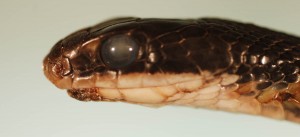Snake Fungal Disease in the United States – NWHC Wildlife Health Bulletin

Photograph by D.E. Green, USGS National Wildlife Health Center.
Snake Fungal Disease (SFD) is an emerging disease in certain populations of wild snakes in the eastern and midwestern United States. While fungal infections were occasionally reported in wild snakes prior to 2006, recently the number of free-ranging snakes with fungal dermatitis submitted to the USGS National Wildlife Health Center (NWHC) and other diagnostic laboratories has been increasing. Laboratory analyses have demonstrated that the fungus Chrysosporium ophiodiicola is consistently associated with SFD, but often, additional fungi are isolated from affected snakes. At this time, definitive evidence that C. ophiodiicola causes SFD is inconclusive. As its name implies, SFD is only known to afflict snakes.
Several agencies, organizations, researchers, and other key stakeholders, including the NWHC, are working together to investigate this potentially emerging disease and to learn more about the impacts that SFD is having on snake populations in the eastern and midwestern United States. We encourage conservation agencies and natural resource managers to contact the NWHC if snakes with clinical signs consistent with SFD are encountered.
For the full wildlife health bulletin, please visit http://www.nwhc.usgs.gov/publications/wildlife_health_bulletins/WHB_2013-02_Snake_Fungal_Disease.pdf
http://www.nwhc.usgs.gov/publications/wildlife_health_bulletins/index.jsp



1 Response
[…] Apr 2013 Source: Canadian Cooperative Wildlife Health Centre (CCWHC)/Healthy Wildlife [edited] <Snake Fungal Disease in the United States – NWHC Wildlife Health Bulletin | Healthy Wildlife> Snake fungal disease (SFD) is an emerging disease in certain populations of wild snakes in […]